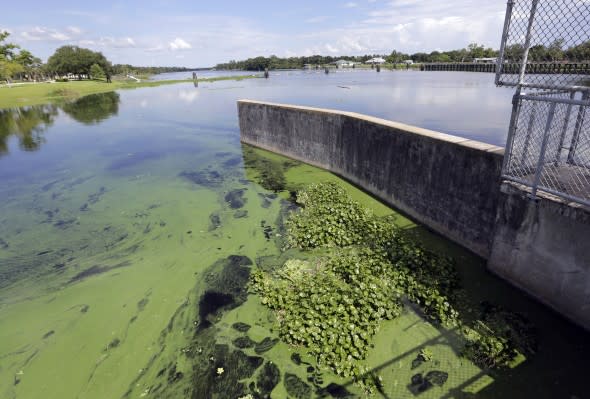Toxic blue-green algae plagues South Florida's waterways; Governor declares state of emergency
Toxic cyanobacteria, also known as blue-green algae, are once again plaguing waterways in South Florida, including the state's largest body of freshwater, Lake Okeechobee, which is also the second-largest freshwater body in the contiguous United States.
Since June, the pungent-smelling algae bloom has reportedly covered 90 percent of the lake's 730-square-mile surface in less than a month's time. May's record rainfall in combination with summer warmth have contributed to the algae bloom's growth.
Algae also polluted Lake Okeechobee and spread to Florida's beaches in 2016.
The current issue has impacted waterways in seven counties, including Okeechobee, Palm Beach and St. Lucie, prompting Gov. Rick Scott to issue a state of emergency for affected areas.

An algae bloom is on the Caloosahatchee River at the W.P. Franklin Lock and Dam on July 12, 2018, in Alva, Florida. Water releases from Lake Okeechobee toward both Florida coasts will resume Friday amid political backlash and a toxic algae bloom. (AP Photo/Lynne Sladky)
The order allows the South Florida Water Management District and the Department of Environmental Protection to waive restrictions to store water in additional areas south of Lake Okeechobee, the Sun Sentinel reported.
The blue-green algae pose potential threats to the tourism economy in South Florida during its peak tourism months.
Those living downstream of Lake Okeechobee are particularly concerned about the toxic algae bloom and its health threats as the U.S. Army Corps of Engineers Jacksonville District reopens the floodgates on the lake, releasing water into the Caloosahatchee and St. Lucie estuaries in order to handle the risk of flooding in the region.
"The current conditions at Lake Okeechobee highlight the challenge of balancing the multiple threats to the public - those associated with floodwaters around the lake that are prompting water to be released and those associated with possible downstream exposure to algal toxins in the released water containing cyanobacteria," said Dr. Diane Mas, REHS/RS, associate at civil and environmental engineering consulting firm Fuss and O'Neill.
The U.S. Army Corps of Engineers said that its flood-risk-management decision is based on the fact that a major breach of the 143-mile Herbert Hoover Dike surrounding Lake Okeechobee would threaten 37,000 people living nearby, potentially damaging homes, businesses, structures and roads, and proving costly to remove water from flooded areas.
"We acknowledge the multiple challenges in this system, including this summer's extensive algal blooms," Jacksonville District Commander Col. Jason Kirk said in a press release.
"Through our federal-state dike rehabilitation and Everglades restoration efforts, along with the state and local community investments to control nutrients from the lake and adjacent waterways, we are collective on the path to remedying these multiple challenges," Kirk said.
After having briefly suspended water releases from Lake Okeechobee to Caloosahatchee and St. Lucie estuaries, the U.S. Army Corps of Engineers announced a 14-day pulse release schedule for water releases from the lake, set to resume July 13 as the lake's water levels approach 14.5 feet.
Potential health impacts
Algae samples taken on July 5 at the St. Lucie Lock in Stuart revealed that the toxins present in the algae had reached dangerous levels of 154 micrograms per liter, which is 15 times higher than levels considered low risk by the World Health Organization, according to the Palm Beach Post.
"We are documenting the abundance of the algae at a number of stations along the lake and along the Caloosahatchee River, and are measuring the amount and different types of toxins in the algae and water," said Marine Biology and Ecology Professor Larry Brand of the University of Miami's Rosenstiel School of Marine and Atmospheric Science.
Brand said he and fellow researchers are also developing new techniques for measuring the amount of toxins present in the air, and are concerned that breathing in the toxins could pose an additional health risk.
"Hopefully, people know not to swim in the water or eat the fish," he said.
While not all blue-green algae produce toxins, exposure to certain types could cause health problems including itchy skin, diarrhea, allergic reactions, difficulty breathing and nausea or vomiting, according to the New York State Department of Health.
"As long as the conditions that encourage bloom formation are present - nutrient pollution, high temperatures and relatively calm waters - this threat will persist," Mas said.
